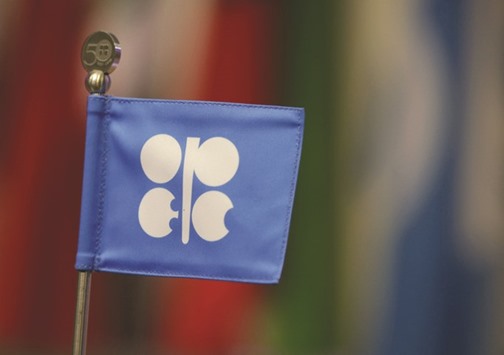Opec’s oil output rose in April to close to the highest level in recent history, a Reuters survey found yesterday, as production increases led by Iran and Iraq more than offset a strike in Kuwait and other outages.
Top exporter Saudi Arabia, however, made no major change to output, the survey found, despite the kingdom hinting it could boost supply after Opec and non-member nations failed to agree to freeze output at a meeting on April 17.
Oil has rebounded more than 75% from a 12-year low in January to reach $48 a barrel, helped by the freeze initiative and signs that lower prices are starting to curb higher-cost supply, despite high inventories and other persistent reminders of a glut.
“The market is massively oversupplied,” said Eugen Weinberg, analyst at Commerzbank in Frankfurt. “This rally doesn’t have strong legs.”
Supply from the Organisation of the Petroleum Exporting Countries rose to 32.64mn barrels per day (bpd) this month, from 32.47mn bpd in March, according to the survey, based on shipping data and information from sources at oil companies, Opec and consultants.
That almost matches January’s 32.65mn bpd, when Indonesia’s return as an Opec member boosted production and output from the other 12 members was the highest in Reuters survey records, starting in 1997.
Opec output has surged since it abandoned in 2014 its historic role of cutting supply to prop up prices, led by higher supply from Saudi Arabia and Iraq.
Iran saw the sharpest increase in production in April after Western sanctions were lifted in January. Tehran, which wants to recover the market share it lost, has refused to limit its supply until it reaches pre-sanctions output.
At 3.40mn bpd, Iranian output is within sight of the 3.50mn bpd it pumped at the end of 2011 before sanctions were tightened, according to Reuters surveys. However, some of the crude may have come from storage, giving a temporary boost to April supply, sources said.
Iraq, which saw the fastest growth in production in Opec in 2015, also raised output. Southern exports have risen to what may be a new record in April —depending on whether tankers loading at the end of the month are treated as April or May. Shipments of Kurdish crude from the north also rose.
Opec’s third-largest supply increase in April came from the UAE, following the end of maintenance work on oilfields that produce Murban crude. Of the countries that reduced output, the largest decline was in Kuwait due to a three-day workers’ strike which temporarily more than halved oil output and curbed refinery operations.
Nigerian output fell due to the continued lack of Forcados crude exports and a brief disruption to shipments of another stream, Brass River. Repairs on a pipeline to the Forcados terminal will take until June, the government said.
Loading problems, power failures and other problems dented Venezuela’s supply by an estimated 40,000 bpd. Oil services firm Schlumberger is cutting activity in the cash-strapped nation, posing a threat to future output.
Saudi Arabia kept output steady compared with March, sources in the survey said, even though use in domestic power plants is rising. Saudi production was estimated at 10.15mn bpd versus 10.18mn in March.
“Exports are lower,” said a source who monitors Saudi output. “The month is not over yet so let’s wait for the final number, but that’s what I am seeing here and now.”
Saudi oil output will edge up close to record highs in coming weeks to meet summer demand for power but is unlikely to be pushed to the limit and flood global markets, Saudi-based industry sources said.
Production may rise to around 10.5mn barrels per day (bpd) during summer, the sources said. Supply in April has held steady to slightly lower at about 10.15mn bpd, said three industry sources who monitor Saudi output.
But Saudi-based industry sources told Reuters that Riyadh does not plan to dump more oil into the market if there is no demand.
The sources said production would likely stay at 10.2-10.3mn bpd and could rise by some 200,000-300,000 bpd in the hot summer months to around 10.5mn.
Opec meets on June 2 in Vienna and may discuss the freeze initiative again. However, Opec officials have been encouraged by the price recovery, which may take the urgency out of a renewed attempt to forge a deal.
Brent oil set for biggest monthly gain in seven years
Reuters/London
Brent crude was heading for its biggest monthly rise in seven years yesterday, touching 2016 highs as a weak dollar and falling US production tempered concerns about an excess of physical oil.
A looming rise in Middle East output capped gains, but investor sentiment held the optimism that has helped lift oil futures nearly 80% higher than January lows.
Brent futures were trading at $48.26 a barrel at 1351 GMT, up 12¢ from their last close. US crude was up 57¢ at $46.60 a barrel, with both contracts hitting 2016 highs earlier in the session.
Investment bank Jefferies said the market “is coming into better balance” and would flip into undersupply in the second half of the year.
But others warned that the rally was happening too soon, driven in large part by investors taking speculative positions.
“The issue is that we haven’t seen price rallies ... correlate with fundamentals,” said Hamza Khan, senior commodity strategist at ING. “The fundamentals - high stocks, high production — haven’t changed.”
Analysts polled by Reuters raised their average forecast for Brent in 2016 to $42.30 per barrel, the second consecutive month of increases.
Bank of America Merrill Lynch said in a note that “non-Opec oil supply is indeed hanging off a cliff”, and estimated that global output would contract year on year in April or May for the first time since 2013.
A weakening dollar also supported oil by making dollar-priced crude cheaper for holders of other currencies.
There are growing risks that production in Opec member Venezuela could decline. Risk consultancy Eurasia Group said the state was running out of cash to keep its oil pumps running.
“Mounting problems will probably lead to a decline of 100,000-150,000 bpd this year,” Eurasia Group said.

Supply from the Opec rose to 32.64mn barrels per day (bpd) this month, from 32.47mn bpd in March, according to the survey, based on shipping data and information from sources at oil companies, the Opec and consultants.


